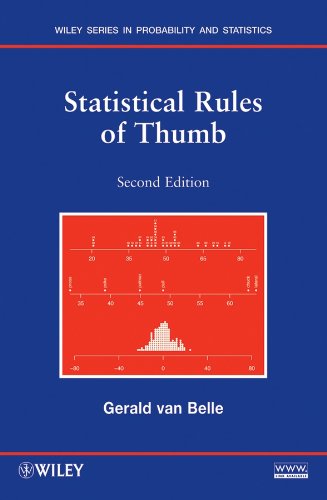Statistical rules of thumb ebook
Par horton scott le mercredi, juillet 6 2016, 22:11 - Lien permanent
Statistical rules of thumb. Gerald van Belle

Statistical.rules.of.thumb.pdf
ISBN: 0470144483,9780470144480 | 305 pages | 8 Mb

Statistical rules of thumb Gerald van Belle
Publisher: Wiley
System (BOG), Poole presented a reactive rule of thumb that he argued could serve as a robust guide to policy decisions (Poole, 1971). More recently, as president of the Federal Reserve different statistical properties of the alternative measures could in principle influence, perhaps in subtle ways, the specification of a rule of thumb. Sources for Further Statistical Information. Version B Source: Statistical Rules of Thumb by Gerald van Belle; http://vanbelle.org/. (Remember the sampling statistics rule of thumb of 2=4 that I have explained before wherein a halving of confidence interval error rate, say from 3% to 1.5%, requires a quadrupling of [] Reply. Some other small sample rules of thumb like the “flip flop” test and “shortfall less than 1” rule were also considered, but didn't seem to be given substantial weight. -The first is that while real women may have curves, women's statistical curves are tighter than men's. An Unstable Okun's Law, Not the Best Rule of Thumb Brent Meyer and Murat Tasci 06.07.12 Okun's law is a statistical relationship. Several responses; I posit that what's going on with this wage spread is two statistical rules of thumb. Here, then, are the rules-of-thumb for predicting the Oscars: 1. Intangible Assets including goodwill and leasehold may be included, but normally only in Rules of Thumb based on earnings/cash flow. Gerard van Belle's Statistical Rules of Thumb has piqued my curiosity at conferences. The idea is to focus on those variables that have some logical meaning rather than being statistical artifacts. Rules of thumb can be very helpful, but they are often pretty coarse. Nearly four decades ago, as staff economist at the Board of Governors of the Federal Reserve. The marketer does a statistical test of significance and gets a p-value of 0.04 (remember your business stats class here…). This workshop will use iNZight visualisation tools and other simulation activities to build a conceptual understanding of margin of error, and the “rules of thumb” for testing claims in statistically-based reports. Proponent of rules of thumb for monetary policy. It turns out my work library has a copy, which has been fun to skim, or should I say, to thumb through. A site dedicated to reporting out references for the common rules of thumb we often talk about but rarely remember who said it. As someone who uses statistical models to do the kind of forecasting he seems to be proposing, I couldn't help but wonder: Why stop halfway?